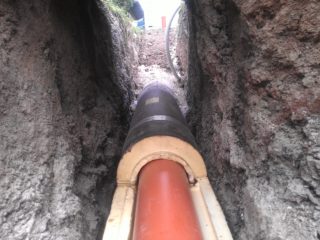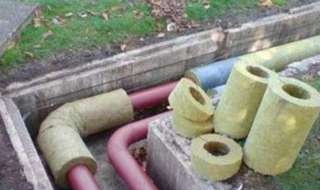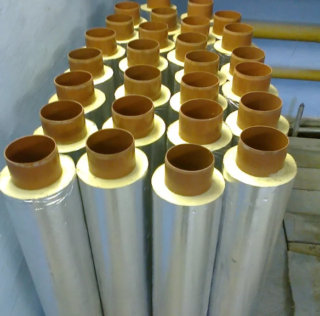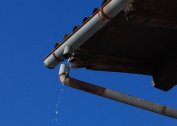Sewage can form an ice plug. This is especially true in cases where the septic tank is located far from home, and the level of the trunk is not deep, that is, it is in the zone of low temperatures. If the sewage system is not insulated during installation, an ice jam may occur in the winter season, which can break through the pipe and permanently disable the system.
In what cases is it necessary to insulate the pipes
Even in the warmest regions, situations happen when the thermometer column drops below zero degrees. Water at this temperature freezes. Congestion can occur at night when sewerage is not used and water stagnates inside the pipe. This happens most often when solid particles are present in the wastewater. They form a cork quickly. It will take time to find a problem place, dig it out, warm it with instruments and rinse. Not the fact that the next night the blockage does not form again. Therefore, the only way to protect yourself from inconvenience is to make insulation of the external sewage pipes at the installation stage.
It is necessary to insulate the pipeline in the following cases:
- The depth of the sewage laying is less than 160 cm. Pipes are rarely laid at such a depth in an autonomous home system, because digging trenches will cost more than buying materials for insulation. The septic tank, taking into account the slope of the highway, will have to be installed at least 2.5 m in depth. Repairing pipes with such a deepening will be problematic, not to mention the additional costs of installing inspection wells.
- In the northern regions, even at 160 cm, the soil freezes strongly and for a long time, so the use of insulation is a guarantee of comfort and integrity of the sewer system.
- Insulation for sewer pipes in the ground is necessary if it was not possible to carry out a gravity system and a pump is used to move the drains. When disconnected, an ice plug may occur that the pump cannot push out and break or break the pipe.
- The diameter of the outer line is 110 cm or less. In this case, the water inside will freeze quickly, even if the septic tank is located nearby.
- The ingress of dirt into the sewer forms a clot of ice and debris, which will be difficult to rinse with water from the house.
The ventilation system of the sewerage of a private house requires warming, since condensate formed at low temperatures will drain down and emit unpleasant odors.
Which parts of the pipeline require special attention
Particularly vulnerable to low temperatures are pipe sections that are located when leaving the house - at the junction of internal and external sewers. This place is actually in the air, whose temperature is much lower than in the ground.
If a pump is used for pumping wastewater, the junction of the pipe must also be insulated to prevent freezing. Otherwise, the equipment may be damaged.
Depending on where the effluents are discharged - into a centralized sewage system or into a ditch, this place is also subject to insulation. In front of a common highway, domestic water slows down the flow rate and can easily freeze. The ditch is on the surface of the soil, where the temperature in winter drops to minus values. To use the system, you will have to wait for heat or urgently take measures to eliminate the ice plug.
It is recommended to wrap pipes with insulating materials along the entire length so as not to carry out repair work during the winter cold in frozen ground. In winter, this will have to be done with the help of technology, which will cost more than the same work in the summer.
The main methods of insulation
The most common ways to warm a sewer pipe are:
- the engineering method, in which preliminary calculations are carried out and the trunk is laid deeper than the soil freezes in the region;
- the active method is heating pipes with electricity using a cable;
- thermal insulation - the use of various heaters of artificial origin or natural expanded clay.
Each method has pros and cons.
Laying the sewer below the level of freezing soil
Not always a reliable and affordable method, since the length of the section will not allow to comply with the necessary slope. This method may require a fairly large monetary cost of construction work. Even if you use cast iron products that tolerate cold well, they will cost three times more expensive without taking into account the cost of work. Repairing deeply laid sewers is also expensive. Cheaper to buy synthetics and overlay pipes.
Thermal insulation materials
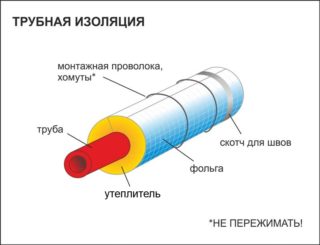 There are many different heaters that wrap the sewer. Foamed polyethylene is most suitable for a basement. Its low density is not effective in soil.
There are many different heaters that wrap the sewer. Foamed polyethylene is most suitable for a basement. Its low density is not effective in soil.
Mineral wool is the most famous insulation, but not the most practical. When wet in the ground, it loses its qualities, so you need to take care of waterproofing. In a dry room, this is a good option.
Penoizol is an expensive but resistant material that is suitable for underground insulation. Construction companies work with him, but for many he can’t afford it.
Penofol - at the same time solves the problem of insulation and waterproofing, therefore it is often used in the installation of sewers. It is cheap.
Expanded clay - a natural material from baked clay is also used as a heater. For this, a layer is poured under the pipes. After laying, the sewage system is sprinkled from above, then soil is introduced and rammed. Expanded clay is resistant to moisture, therefore it is an ideal option for storm sewers.
Polyfoam is a cheap way, but you will need to build something in the form of a box around the highway, and then fill it with crumbs. Polyfoam is often damaged by rodents, so it is recommended to cover the pipes with a metal mesh with small holes.
Styrofoam shell for pipes. Minimum thickness 25 mm, maximum 100 mm. Allows you to maintain the efficiency of the sewage system when laying to a depth of 0.5 m at a temperature of 30 degrees. When overlaying the material at the joint, the places are wrapped with tape so that no shifts occur during sprinkling with soil.
Polyurethane shell - a material that is not sensitive to moisture. Service life is up to 25 years. Made in the form of halves that have a lock. Dress alternately and strengthened with adhesive tape. On top there is additional thermal insulation in the form of a layer of foil.
Electric heating cable
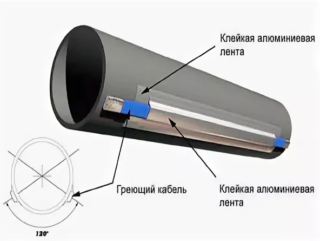 An electric cable of sufficient power is used in the country, where sewers are rarely used. Turning on the heating, in the sewer not only maintain the desired temperature, but also defrost it so that the pipe does not break.
An electric cable of sufficient power is used in the country, where sewers are rarely used. Turning on the heating, in the sewer not only maintain the desired temperature, but also defrost it so that the pipe does not break.
The cord must be positioned along the pipe and taped with tape. Heating is regulated automatically. When the temperature drops below zero degrees, the sensor independently turns on the heating system. You can insulate sewer pipes in a private house with your own hands using an electric cable if you have experience, but in order to avoid electric shock, it is better to invite a master.
A pipe sandwich is a ready-to-install sewer system with an existing insulation made up of several layers.This method is more expensive than buying separately plastic pipes and insulation.
How to insulate ventilation
Only the part that goes onto the roof needs to be protected from freezing. To do this, you need copper wire without winding. It is twisted into a ball along the diameter of the fan pipe. The ends are bent so that you can hook on the edges. The principle of this method is based on the ability of copper to accumulate and give off heat. Warm air rises from the room, warming the wire. It gives off heat to the pipe and melts the ice, which is formed as a result of condensate drainage.
Recommendations for choosing a method of pipe insulation
It is possible to recommend what exactly to choose for insulation of a sewer pipe only when taking into account climatic conditions. The thickness of the material will depend on how far the temperature drops, as well as how deep the trunk is.
When using glass wool, the place where the insulation will be made is taken into account. When incorporating into the ground, it is necessary to buy a waterproofing material and tightly wind it into the pad so that moisture does not get inside.
If the budget allows, it is more practical to use expensive materials, so as not to subsequently overpay for pipe repairs or replacement of insulation.
Material Prices
At first glance, some materials may seem quite cheap, but then it turns out that they need to buy something else to increase the service life. Therefore, it is recommended to focus on the expiration dates of heaters, as well as on the degree of isolation from frost. Some materials have a low density, so they will not save from freezing if they wrap the sewer and lay it in the ground.
The cost may be affected by: the possibility of repeated use, resistance to mechanical damage, the level of thermal conductivity, as well as additional qualities - elimination of vibrations and sound absorption, when it comes to warming sections of internal sewers.
